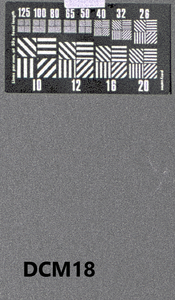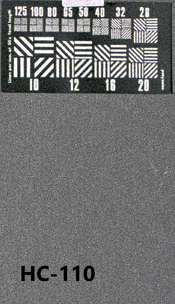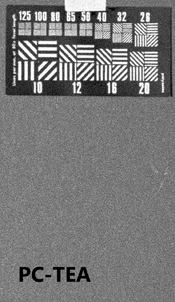Alan Johnson
Subscriber
- Joined
- Nov 16, 2004
- Messages
- 3,220
I wondered if DCM18 [or PCM20] might serve as a long lasting concentrate to replace my syrup HC-110 when it is eventually used up.
HC-110 syrup is discontinued.
PC-TEA is an alternative but is harder to make up as the ascorbic acid is slow to dissolve in TEA.
DCM18- the ascorbic acid dissolves quite easily in the metaborate solution and it is less viscous than PC-TEA.
A resolution chart~5.5 in wide was attached to a Kodak grey card and was photographed on Delta 400 film with a 6 element 50mm lens at f8 from the correct distance illuminated by off camera flash, EI=400.
Sections of the film were developed at 20C HC-110 1+47 8.75m, PC-TEA 1+50 8m, DCM18 1+47 10m.The PC-TEA negatives were slightly more dense.
Negatives were scanned at 3600 dpi true and output with the scanner on auto except for white point adjustment to show the lines on the resolution chart.
jpegs are attached, prints were made on A4 paper.
I concluded that HC-110 and PC-TEA show about the same grain, DCM18 showed less grain.
In support of this result it is noted in The Film Developing Cookbook 2020 p123 that a developer thought to correspond closely to DD-X produces finer grain than "an HC-110 type" developer. Also that DEA causes much higher granularity.
Resolution under the microscope was ~80 lppm at low contrast for PC-TEA and even lower contrast for HC-110 and DCM18.
Conclusion- if DCM18 or a PCM variant prove to be long lasting they could be a substitute for HC-110 syrup.
HC-110 syrup is discontinued.
PC-TEA is an alternative but is harder to make up as the ascorbic acid is slow to dissolve in TEA.
DCM18- the ascorbic acid dissolves quite easily in the metaborate solution and it is less viscous than PC-TEA.
A resolution chart~5.5 in wide was attached to a Kodak grey card and was photographed on Delta 400 film with a 6 element 50mm lens at f8 from the correct distance illuminated by off camera flash, EI=400.
Sections of the film were developed at 20C HC-110 1+47 8.75m, PC-TEA 1+50 8m, DCM18 1+47 10m.The PC-TEA negatives were slightly more dense.
Negatives were scanned at 3600 dpi true and output with the scanner on auto except for white point adjustment to show the lines on the resolution chart.
jpegs are attached, prints were made on A4 paper.
I concluded that HC-110 and PC-TEA show about the same grain, DCM18 showed less grain.
In support of this result it is noted in The Film Developing Cookbook 2020 p123 that a developer thought to correspond closely to DD-X produces finer grain than "an HC-110 type" developer. Also that DEA causes much higher granularity.
Resolution under the microscope was ~80 lppm at low contrast for PC-TEA and even lower contrast for HC-110 and DCM18.
Conclusion- if DCM18 or a PCM variant prove to be long lasting they could be a substitute for HC-110 syrup.
Attachments
Last edited:














